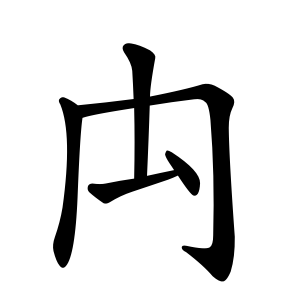禸
- animal footprint;
Etymology
According to the Shuowen Jiezi (説文解字 shuōwén jiězì), this character is an ancient form of 蹂 (to trample, 유). The component ム represents the shape of an animal's foot making an impression on the ground, while 九 serves as the phonetic component in this phono-semantic compound.
Other interpretations describe it as a pictograph representing the body and legs of an animal with a drooping tail.
禸
발자국
유
baljagug
yu
Kangxi radical:114
Strokes:5
Unicode:U+79B8
Cangjie input:
- 戈月 (IB)
Composition:
- ⿻ 冂 厶 (G H J K)
- ⿻ 门 ⿰ 一 丶 (T)
